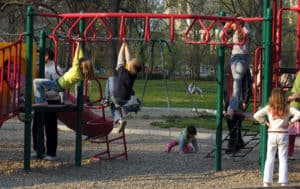For more than a decade, Sadie Dodson has been involved with foster care. As a foster and adoptive mom, she has walked through healing with the many children she has welcomed into her home. So she understands how important it is to prevent child abuse.
Each of the children Sadie has welcomed into her home entered foster care through no fault of their own. Rather, they had experienced abuse, neglect, or abandonment. They were in need of a safe place while their biological family worked to become healthy again.
Sadie’s perspective on child abuse prevention is influenced by her background in psychology, her experience as a foster and adoptive mom, and her current role at a foster care/adoption ministry.
This is what Sadie wants everyone to know about how to prevent child abuse and neglect.

Child abuse and neglect is preventable. However, it requires us to be engaged in the lives of others.
There are several factors that may contribute to potential abuse. Some of the most common conditions that may lead to abuse are mental health challenges, substance use, and poverty. Directly addressing these issues can help to mitigate or eliminate the risk of child abuse.
So how can you make a difference? Get to know your neighbors.
“It’s really helpful for families to invest in other families,” Sadie asserts. “If we see a family struggling, jump in and help.”

Support does not have to be done in a way that causes a family immense shame or embarrassment. Likewise, it should not be done with a “savior” mentality. Rather, families can step up and recognize the challenges that other parents may be facing.
Early intervention can be as simple as getting to know a family in your neighborhood that may be struggling and reaching out. Sadie suggests an empathetic approach. If you are a parent, you can connect by saying, “I’m a parent too. I know how hard it can be. Can I help you?”
Offering babysitting or dropping off some extra groceries could make a world of difference to prevent child abuse from ever beginning. Stress and isolation are additional factors that may lead to child abuse. However, when a community wraps support around a family, that family feels seen. They may also feel empowered to seek help before the situation becomes dire.
Unfortunately, it is not always possible to prevent child abuse before it occurs. When this happens, it is crucial to report any suspected abuse or neglect to the appropriate authorities. Reporting suspected abuse helps prevent future abuse from occurring.
On multiple occasions, people have approached Sadie about a potential abuse situation they’ve observed with a family or child. Because they know Sadie is familiar with the child welfare system, they ask her whether they should report it. Sadie always says, “Yes.”

Sadie knows that reporting potential abuse or neglect can seem daunting. She explains, “I feel like people are scared to call in and report.” But calling in with a concern does not mean you are guaranteeing that a child is experiencing abuse. You do not have to be certain that abuse is occurring in order to report. Reporting suspected abuse simply means you sense something is not right.
Some people are hesitant to report suspected abuse because they feel like it is prying into a family’s private life. But when a child’s safety is at risk, it is always better to report than remain silent. By contacting a child abuse hotline, you are passing along information about the situation to professionals who are trained to handle it. Reporting potential abuse or neglect allows child welfare professionals to take the next step.
Nationally you can call 1-800-4-A-CHILD. Each state also has its own reporting hotline, which you can find with a simple internet search. You may have the option to make a call or to submit an online form. If at any point you witness a child in a life-threatening situation, you should call 911 immediately.
Undoubtedly, the child welfare system is overloaded. Many people wonder whether their report will even make a difference. However, Said has a strong rebuttal for this idea: as Christians, our faith is not in the child welfare system. Our faith is in God. As we report suspected cases of abuse or neglect, we must trust that God is in control of how the information is used to keep children safe.
Additionally, your call or report might not be the first one made about a child or home. Perhaps there was a previous call that was at first unsubstantiated. Your report may prompt further investigation. “You never know when you’re going to be that crucial piece that gets a child the care that they need,” Sadie asserts. Adding your observations to the case’s paper trail may be invaluable. In taking these steps, you help to ensure that abuse stops and that future abuse is prevented.
If child abuse prevention weighs heavy on your heart, there are ways to make a lasting impact. “Becoming a foster parent is a great thing that people can do if they are concerned for children in their community,” Sadie suggests.

There is a huge need for foster parents throughout the United States. When children are removed from their home due to abuse or neglect, they need a safe and loving home to go to. By opening your home to children in foster care, you provide a temporary place for them to live as their biological family works to become safe again.
In becoming a foster home, you help prevent future child abuse. As you care for a child, you provide their family the opportunity to learn parenting skills and stress management tactics. You provide a home for a child while their biological family develops a support network and accesses necessary services. In Sadie’s experience, she knows that “it’s an important role to play to be that safe person for a child.”
If you feel called to consider foster care or adoption, it is important you understand the lasting effects of child abuse. Even if you are not involved with foster care or adoption, it is likely that you will interact with children who have experienced harm. Therefore, it is crucial for everyone to understand the effects of abuse in children.
First, when a child experiences harm, they lose trust in adults. Sadie speaks from her experience as a foster and adoptive mother when she says, “It’s a very hard job for foster and adoptive families to rebuild that trust.” The most important thing a family can do is make sure the child feels safe.
While a foster/adoptive parent might know that a child is safe in their home, it is more important that the child feels safe. Nothing else matters if the child does not feel safe. So a foster/adoptive parent may need to go above and beyond to create “felt safety.”
Sadie provides the example of a bedroom door chime. She has welcomed several children into her home who were once abused in their bedrooms at night. In order to help them feel safe, she installed an inexpensive door alarm or chime on their bedroom door. She would let the child hear the alarm from her own room so they knew no one could enter their room without her knowledge. This contributed to the sense of felt safety.

Only after a child starts to feel safe can they begin to trust. Sadie continues, “As you build safety and trust, you can start to repair some of the attachment damage that has been caused by trauma.” And every positive, safe, trusting attachment bond that a child can form benefits a child in the future.
This insight is important for anyone who may interact with a child who has experienced harm. Foster and adoptive parents certainly should pursue attachment with a child. But other individuals can make a difference by getting attached too. For example, the love and care of a respite care provider/babysitter, Sunday school teacher, or mentor can help a child learn to trust again.
Even if you are with a child for a short time, if they can feel safe, trust you, and connect with you, then it benefits them. It helps repair the damage that’s been done.
The importance of attachment for children in foster care cannot be understated. Sadie knows firsthand that it is hard it is to say goodbye to a child when they reunify with their biological family. However, this attachment will leave a lasting, positive impression on the child.
And if there was one thing that Sadie learned to keep in mind as a foster parent it was that children continue to love their parents despite the harm they may have experienced. “If at all possible, it is best for the child to be back with their family,” Sadie acknowledges. For these reasons, foster parents provide a safe and loving home to a child who has experienced abuse while their biological family seeks help.
These efforts prevent child abuse and neglect from occurring again in the future.
The post How to Prevent Child Abuse: A Foster Parent’s Perspective appeared first on Focus on the Family.
Continue reading...
Each of the children Sadie has welcomed into her home entered foster care through no fault of their own. Rather, they had experienced abuse, neglect, or abandonment. They were in need of a safe place while their biological family worked to become healthy again.
Sadie’s perspective on child abuse prevention is influenced by her background in psychology, her experience as a foster and adoptive mom, and her current role at a foster care/adoption ministry.
This is what Sadie wants everyone to know about how to prevent child abuse and neglect.
Early Intervention

Child abuse and neglect is preventable. However, it requires us to be engaged in the lives of others.
There are several factors that may contribute to potential abuse. Some of the most common conditions that may lead to abuse are mental health challenges, substance use, and poverty. Directly addressing these issues can help to mitigate or eliminate the risk of child abuse.
So how can you make a difference? Get to know your neighbors.
Offer Support
“It’s really helpful for families to invest in other families,” Sadie asserts. “If we see a family struggling, jump in and help.”

Support does not have to be done in a way that causes a family immense shame or embarrassment. Likewise, it should not be done with a “savior” mentality. Rather, families can step up and recognize the challenges that other parents may be facing.
Early intervention can be as simple as getting to know a family in your neighborhood that may be struggling and reaching out. Sadie suggests an empathetic approach. If you are a parent, you can connect by saying, “I’m a parent too. I know how hard it can be. Can I help you?”
Offering babysitting or dropping off some extra groceries could make a world of difference to prevent child abuse from ever beginning. Stress and isolation are additional factors that may lead to child abuse. However, when a community wraps support around a family, that family feels seen. They may also feel empowered to seek help before the situation becomes dire.
Be Bold Enough to Report
Unfortunately, it is not always possible to prevent child abuse before it occurs. When this happens, it is crucial to report any suspected abuse or neglect to the appropriate authorities. Reporting suspected abuse helps prevent future abuse from occurring.
Always Report
On multiple occasions, people have approached Sadie about a potential abuse situation they’ve observed with a family or child. Because they know Sadie is familiar with the child welfare system, they ask her whether they should report it. Sadie always says, “Yes.”
Overcome Hesitations

Sadie knows that reporting potential abuse or neglect can seem daunting. She explains, “I feel like people are scared to call in and report.” But calling in with a concern does not mean you are guaranteeing that a child is experiencing abuse. You do not have to be certain that abuse is occurring in order to report. Reporting suspected abuse simply means you sense something is not right.
Some people are hesitant to report suspected abuse because they feel like it is prying into a family’s private life. But when a child’s safety is at risk, it is always better to report than remain silent. By contacting a child abuse hotline, you are passing along information about the situation to professionals who are trained to handle it. Reporting potential abuse or neglect allows child welfare professionals to take the next step.
How to Report
Nationally you can call 1-800-4-A-CHILD. Each state also has its own reporting hotline, which you can find with a simple internet search. You may have the option to make a call or to submit an online form. If at any point you witness a child in a life-threatening situation, you should call 911 immediately.
Your Report Might Make All the Difference
Undoubtedly, the child welfare system is overloaded. Many people wonder whether their report will even make a difference. However, Said has a strong rebuttal for this idea: as Christians, our faith is not in the child welfare system. Our faith is in God. As we report suspected cases of abuse or neglect, we must trust that God is in control of how the information is used to keep children safe.
Additionally, your call or report might not be the first one made about a child or home. Perhaps there was a previous call that was at first unsubstantiated. Your report may prompt further investigation. “You never know when you’re going to be that crucial piece that gets a child the care that they need,” Sadie asserts. Adding your observations to the case’s paper trail may be invaluable. In taking these steps, you help to ensure that abuse stops and that future abuse is prevented.
Taking Further Action to Prevent Child Abuse
If child abuse prevention weighs heavy on your heart, there are ways to make a lasting impact. “Becoming a foster parent is a great thing that people can do if they are concerned for children in their community,” Sadie suggests.

There is a huge need for foster parents throughout the United States. When children are removed from their home due to abuse or neglect, they need a safe and loving home to go to. By opening your home to children in foster care, you provide a temporary place for them to live as their biological family works to become safe again.
In becoming a foster home, you help prevent future child abuse. As you care for a child, you provide their family the opportunity to learn parenting skills and stress management tactics. You provide a home for a child while their biological family develops a support network and accesses necessary services. In Sadie’s experience, she knows that “it’s an important role to play to be that safe person for a child.”
Addressing the Effects of Abuse in Children
If you feel called to consider foster care or adoption, it is important you understand the lasting effects of child abuse. Even if you are not involved with foster care or adoption, it is likely that you will interact with children who have experienced harm. Therefore, it is crucial for everyone to understand the effects of abuse in children.
Felt Safety Builds Trust
First, when a child experiences harm, they lose trust in adults. Sadie speaks from her experience as a foster and adoptive mother when she says, “It’s a very hard job for foster and adoptive families to rebuild that trust.” The most important thing a family can do is make sure the child feels safe.
While a foster/adoptive parent might know that a child is safe in their home, it is more important that the child feels safe. Nothing else matters if the child does not feel safe. So a foster/adoptive parent may need to go above and beyond to create “felt safety.”
Sadie provides the example of a bedroom door chime. She has welcomed several children into her home who were once abused in their bedrooms at night. In order to help them feel safe, she installed an inexpensive door alarm or chime on their bedroom door. She would let the child hear the alarm from her own room so they knew no one could enter their room without her knowledge. This contributed to the sense of felt safety.
Trust Helps Repair Damage

Only after a child starts to feel safe can they begin to trust. Sadie continues, “As you build safety and trust, you can start to repair some of the attachment damage that has been caused by trauma.” And every positive, safe, trusting attachment bond that a child can form benefits a child in the future.
This insight is important for anyone who may interact with a child who has experienced harm. Foster and adoptive parents certainly should pursue attachment with a child. But other individuals can make a difference by getting attached too. For example, the love and care of a respite care provider/babysitter, Sunday school teacher, or mentor can help a child learn to trust again.
Even if you are with a child for a short time, if they can feel safe, trust you, and connect with you, then it benefits them. It helps repair the damage that’s been done.
Attachment Leads to Healing
The importance of attachment for children in foster care cannot be understated. Sadie knows firsthand that it is hard it is to say goodbye to a child when they reunify with their biological family. However, this attachment will leave a lasting, positive impression on the child.
And if there was one thing that Sadie learned to keep in mind as a foster parent it was that children continue to love their parents despite the harm they may have experienced. “If at all possible, it is best for the child to be back with their family,” Sadie acknowledges. For these reasons, foster parents provide a safe and loving home to a child who has experienced abuse while their biological family seeks help.
These efforts prevent child abuse and neglect from occurring again in the future.
The post How to Prevent Child Abuse: A Foster Parent’s Perspective appeared first on Focus on the Family.
Continue reading...





